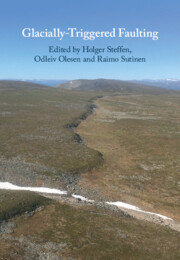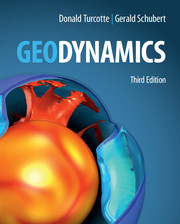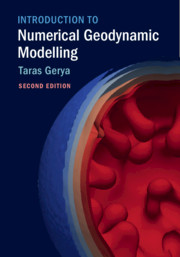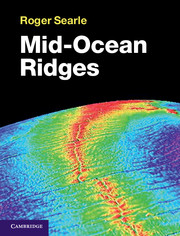Glacially-Triggered Faulting
£95.00
- Editors:
- Holger Steffen, Lantmäteriet, Sweden
- Odleiv Olesen, Geological Survey of Norway
- Raimo Sutinen, Geological Survey of Finland
- Date Published: December 2021
- availability: In stock
- format: Hardback
- isbn: 9781108490023
£
95.00
Hardback
Other available formats:
eBook
Looking for an inspection copy?
This title is not currently available on inspection
-
Glacially triggered faulting describes movement of pre-existing faults caused by a combination of tectonic and glacially induced isostatic stresses. The most impressive fault-scarps are found in northern Europe, assumed to be reactivated at the end of the deglaciation. This view has been challenged as new faults have been discovered globally with advanced techniques such as LiDAR, and fault activity dating has shown several phases of reactivation thousands of years after deglaciation ended. This book summarizes the current state-of-the-art research in glacially triggered faulting, discussing the theoretical aspects that explain the presence of glacially induced structures and reviews the geological, geophysical, geodetic and geomorphological investigation methods. Written by a team of international experts, it provides the first global overview of confirmed and proposed glacially induced faults, and provides an outline for modelling these stresses and features. It is a go-to reference for geoscientists and engineers interested in ice sheet-solid Earth interaction.
Read more- Supported by an online database of all known glacially induced faults to date at www.cambridge.org/9781108490023
- Revises the common understanding of glacially triggered faulting and places it within the context with intraplate seismicity, showing how new results have led to adjustment of theory and models
- Includes open research questions on glacially triggered faulting, providing an accessible summary of the key problems and current research goals
Customer reviews
Not yet reviewed
Be the first to review
Review was not posted due to profanity
×Product details
- Date Published: December 2021
- format: Hardback
- isbn: 9781108490023
- length: 460 pages
- dimensions: 250 x 174 x 26 mm
- weight: 1.08kg
- availability: In stock
Table of Contents
Part I. Introduction:
1. Glacially-Triggered Faulting – A Historical Overview and Recent Developments H. Steffen, O. Olesen and R. Sutinen
2. Geomechanics of Glacially-Triggered Faulting R. Steffen, P. Wu and B. Lund
Part II. Methods and Techniques for Fault Identification and Dating:
3. Earthquake-Induced Landforms in the Context of Ice-Sheet Loading and Unloading P. B. E. Sandersen and R. Sutinen
4. The Challenge to Distinguish Soft-Sediment Deformation Structures (SSDS) Formed by Glaciotectonic, Periglacial and Seismic Processes in a Formerly Glaciated Area: A Review and Synthesis K. Müller, J. Winsemann, M. Pisarska-Jamroży, T. Lege, T. Spies, and C. Brandes
5. Glacially Induced Fault Identification with LiDAR, Based on Examples from Finland J.-P. Palmu, A. Ojala, J. Mattila, M. Markovaara-Koivisto, T. Ruskeeniemi, R. Sutinen, T. Bauer and M. Keiding
6. Fault Identification from Seismology N. Gestermann and T. Plenefisch
7. Imaging and Characterization of Glacially Induced Faults Using Applied Geophysics R. Beckel, C. Juhlin, A. Malehmir and O. Ahmadi
8. Dating of Postglacial Faults in Fennoscandia C. A. Smith, A. Ojala, S. Grigull and H. Mikko
9. Proposed Drilling into Postglacial Faults: The Pärvie Fault System M. Ask, I. Kukkonen, O. Olesen, B. Lund, Å. Fagereng, J. Rutqvist, J.-E. Rosberg and H. Lorenz
Part III. Glacially Triggered Faulting in the Fennoscandian Shield:
10. Seismicity and Sources of Stress in Fennoscandia S. Gregersen, C. Lindholm, A. Korja, B. Lund, M. Uski, K. Oinonen, P. H. Voss and M. Keiding
11. Postglacial Faulting in Norway: Large Magnitude Earthquakes of the Late Holocene Age O. Olesen, L. Olsen, S. Gibbons, B. O. Ruud, F. Høgaas, T. A. Johansen and T. Kværna
12. Glacially Induced Faults in Sweden: The Rise and Reassessment of the Single-Rupture Hypothesis C. A. Smith, H. Mikko and S. Grigull
13. Glacially Induced Faults in Finland R. Sutinen, E. Hyvönen, M. Markovaara-Koivisto, M. Middleton, A. Ojala, J.-P. Palmu, T. Ruskeeniemi and J. Mattila
14. Late- and Postglacial Faults in the Russian Part of the Fennoscandian Shield S. Nikolaeva, A. Nikonov and S. Shvarev
Part IV. Glacially Triggered Faulting at the Edge and in the Periphery of the Fennoscandian Sheild:
15. Late– and Postglacial Faulting in Denmark P. B. E. Sandersen, S. Gregersen and P. Voss
16. Glacially Induced Faults in Germany K. Müller, J. Winsemann, D. Tanner, T. Lege, T. Spies and C. Brandes
17. Glacially Induced Faulting in Poland M. Pisarska-Jamroży, P. P. Wozniak and T. van Loon
18. Soft-Sediment Deformation Structures in the Eastern Baltic Region: Implication in Seismicity and Glacially Triggered Faulting A. Bitinas, J. Lazauskienė and M. Pisarska-Jamroży
Part V. Glacially Triggered Faulting Outside Europe:
19. The Search for Glacially Induced Faults in Eastern Canada J. Adams and G. Brooks
20. Glacially Induced Faulting in Alaska J. Sauber, C. Rollins, J. T. Freymueller and N. A. Ruppert
21. Indications on Glacially Triggered Faulting in Polar Areas H. Steffen and R. Steffen
Part VI. Modelling of Glacially Induced Faults and Stress:
22. Glacial Isostatic Adjustment Models for Earthquake Triggering P. Wu, R. Steffen, H. Steffen and B. Lund
23. Crustal-Scale Stress Modelling to Investigate Glacially Triggered Faulting S. Gradmann and R. Steffen
Part VII. Outlook:
24. Future Research on Glacially Triggered Faulting and Intraplate Seismicity O. Olesen, H. Steffen and R. Sutinen-
General Resources
Find resources associated with this title
Type Name Unlocked * Format Size Showing of
This title is supported by one or more locked resources. Access to locked resources is granted exclusively by Cambridge University Press to lecturers whose faculty status has been verified. To gain access to locked resources, lecturers should sign in to or register for a Cambridge user account.
Please use locked resources responsibly and exercise your professional discretion when choosing how you share these materials with your students. Other lecturers may wish to use locked resources for assessment purposes and their usefulness is undermined when the source files (for example, solution manuals or test banks) are shared online or via social networks.
Supplementary resources are subject to copyright. Lecturers are permitted to view, print or download these resources for use in their teaching, but may not change them or use them for commercial gain.
If you are having problems accessing these resources please contact [email protected].
Sorry, this resource is locked
Please register or sign in to request access. If you are having problems accessing these resources please email [email protected]
Register Sign in» Proceed
You are now leaving the Cambridge University Press website. Your eBook purchase and download will be completed by our partner www.ebooks.com. Please see the permission section of the www.ebooks.com catalogue page for details of the print & copy limits on our eBooks.
Continue ×Are you sure you want to delete your account?
This cannot be undone.
Thank you for your feedback which will help us improve our service.
If you requested a response, we will make sure to get back to you shortly.
×






